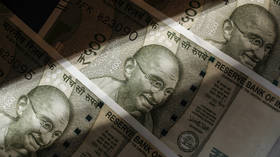Indian central bank frames roadmap to take rupee global

As India’s international trade and investment flows soar, New Delhi is taking steps towards making the Indian rupee (INR) a strong international currency that could be an alternative to the US dollar.
A fresh report of the working group of the Reserve Bank of India (RBI), made public on Wednesday, stated that INR had the potential to become an internationalized currency, as India is one of the fastest growing countries and “has shown remarkable resilience even in the face of major headwinds.” In the last decade, India’s foreign exchange reserves have grown from $290.5 billion in August 2012 to $560.4 billion in August 2022. In the last decade, India’s Foreign Direct Investment (FDI) has almost doubled from $46.6 billion to $84.8 billion.
The 70-page document names several factors that set the stage for various alternative currencies, including the rupee, to potentially use in international transactions. They include increased linkages of the Indian economy with the rest of the world in terms of trade and capital flows, the global financial system moving towards being multipolar “as reflected in the steadily decreasing share of USD in foreign exchange reserves of countries” and “recent geopolitical developments.”
The working group outlined a roadmap for rupee internationalization, pointing out that some of the steps described have already been initiated and are currently a “work in progress.” The document also notes the need to move gradually and resolve issues related to this move, including challenges it poses to the stability of domestic currency and the country’s overall monetary policy.
Measures proposed include adopting a standardized approach for examining the proposals on bilateral and multilateral trade in rupees, enabling the INR as an additional settlement currency in multilateral mechanisms such as the Asian Clearing Union, encouraging opening up rupee accounts for non-residents both in and outside the country, and integrating the Indian payment systems with other countries for cross-border transactions. Indian exporters should be provided “equitable incentives” for settling trade in rupees, the working group recommended.
Citing the rise in prominence of Chinese yuan as an international currency, the report noted it had occurred in spite of Beijing “retaining capital controls in many areas.”
“China’s export-oriented manufacturing sector provides the basis for internationalization of the renminbi and this is supplemented by arrangements with partner countries in the form of bilateral currency swaps,” the document reads, noting the important role that bilateral currency swaps can play in the internationalization of INR.
Over the medium term, the group recommended reviewing taxes on so-called Masala bonds (issued outside India but denominated in INR) and harmonizing tax regimes of India and other financial centers, as well as allowing banking services in rupees outside India through offshore branches of Indian banks. The proposals outlined in the document will be examined for implementation, RBI said, noting that the report did not reflect the official position of the regulator.
Debates around the internalization of rupees have been raging in India for over a decade, but intensified lately in the view of the Ukrainian crisis and Western sanctions against Russia – India’s key trading partner for defense and energy supplies. In July 2022, RBI unveiled a mechanism to settle international trade in rupees. Exports and imports under this arrangement may be denominated and invoiced in INR, while the exchange rate between the currencies of the two trading partner countries may be market determined. The mechanism allows settling import and export payments through Special Vostro Rupee accounts that domestic banks hold for foreign banks in Indian rupees.
In March this year, the government announced that banks from 18 countries got permission from RBI to open such accounts for settling payments in Indian rupees. The list includes Russia and Iran, both of which are cut-off from the global financial system, and several African countries, Sri Lanka, Myanmar, Israel, New Zealand and the UK.














